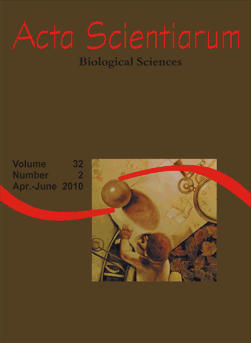<b>Does <em>Heliocarpus popayanensis</em> Kunth (Malvaceae) tolerate substract’s hypoxy?</b> - doi: 10.4025/actascibiolsci.v32i2.3566
Keywords:
Anatomy, tropical tree species, content of nutrients, morphology
Abstract
The species Heliocarpus popayanensis is used on floristic recomposition of degraded areas, wich’s soil might present hypoxy. Considering these aspects, this studies evaluates this species answers to flooding. Young plants were submitted to drained and flooded substract for 30 and 60 days, then flooded for 30 days and then drained for more 30 days. Main root and stem length, area and number of leaves, biomass and relative growth rate of roots, stems and leaves and the nutritional content of leaves were determined. Until 60 days of flooding there was a percentual reduction in biomass (38%), in RGR (77%) and in the area of leaves, including reduction in root and stem’s diameter (70%), and in the lignification of floematic cells. There was no anatomic alteration in leaves, but there was reduction of nutrients concentration (N, P, K, Fe, Cu, B). Therefore, young plants of the species Heliocarpus popayanensis survive to the flooding period considered above, probably due to anatomical and morphologic alterations. The rarity of this species in flooded area is probably related to other stages of the life cycle, such as seeds germination or competition with other species in the environment.Downloads
Download data is not yet available.
Published
2010-05-24
How to Cite
Pisicchio, C. M., Bianchini, E., Pimenta, J. A., Sert, M. A., Davanso-Fabro, V. M., & Medri, M. E. (2010). <b>Does <em>Heliocarpus popayanensis</em> Kunth (Malvaceae) tolerate substract’s hypoxy?</b> - doi: 10.4025/actascibiolsci.v32i2.3566. Acta Scientiarum. Biological Sciences, 32(2), 201-209. https://doi.org/10.4025/actascibiolsci.v32i2.3566
Issue
Section
Vegetable Morphology & Physiology
DECLARATION OF ORIGINALITY AND COPYRIGHTS
I Declare that current article is original and has not been submitted for publication, in part or in whole, to any other national or international journal.
The copyrights belong exclusively to the authors. Published content is licensed under Creative Commons Attribution 4.0 (CC BY 4.0) guidelines, which allows sharing (copy and distribution of the material in any medium or format) and adaptation (remix, transform, and build upon the material) for any purpose, even commercially, under the terms of attribution.
Read this link for further information on how to use CC BY 4.0 properly.
0.6
2019CiteScore
31st percentile
Powered by 

0.6
2019CiteScore
31st percentile
Powered by 











1.png)




3.png)













